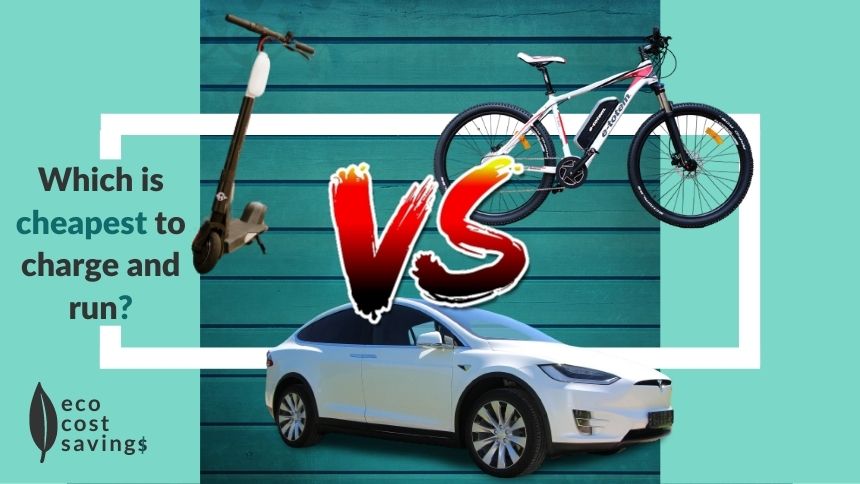Last updated: January 31, 2024.
Which has the lowest charging and running costs, electric scooters, electric bikes or electric cars? Find out below.
Electric scooters, electric bikes and electric cars are some of the most popular forms of greener transport. And they’re only growing in popularity. But which has the lowest impact on electricity bills?
Key insights:
(1) Taking the most popular models in each category, electric scooters are typically the cheapest to charge. They have slightly less battery capacity compared to electric bikes and, therefore, consume less electricity to fully charge. However, electric bikes are more efficient – their electricity cost per mile is slightly lower than e scooters.
(2) It’s no surprise that electric cars are the most expensive to charge and run.
The table below shows the electricity cost per charge, mile and year, if each was used as much as an average US driver.

The authoritative source for energy efficiency insights
These study results and our proprietary tools have garnered recognition and citations from esteemed entities such as:
- The U.S. Department of Transportation;
- Renewable Energy Magazine; and
- Industry leaders including Marin Bikes and Apollo.
Additionally, our calculators are recognized as valuable resources for vehicle comparison in electric mobility infrastructure planning.
Esteemed institutions, the U.S. Department of Energy, the Joint Office of Energy and Transportation, and the U.S. Department of Transportation, have featured our tools in their pivotal report, “Charging Forward: A Toolkit for Planning and Funding Urban Electric Mobility Infrastructure.”
Ultimately, you can trust our research, calculations, and unbiased analysis, just like so many others do.
What is the cost per charge, mile and year of the EVs?
Using the Electric Scooter Electricity Cost Calculator, Electric Bike Electricity Cost Calculator and the Electric Car Electricity Cost Calculator, we can easily work out and compare, at 15c per kWh, the average US charging costs of the most popular electric scooter, bike and car.
| EV type | Most Popular Model | Cost of 1 charge | Cost to reach 13,476 miles | Cost per mile |
| Electric scooter | Xiaomi Mi M365 | $0.042 | $29.79 | $0.0022 |
| Electric bike | Ancheer Electric Mountain Bike | $0.056 | $24.43 | $0.0018 |
| Electric car | Tesla Model 3 | $9.38 | $485.14 | $0.04 |
Compared to the most popular electric bike, the electric scooter costs 1.4 cents less to charge, but costs slightly more, 0.0004 cents, per mile. If used to travel the average distance of US drivers, 13,476 miles, electric scooters cost $5.36 more to run than the eBike.
Electric cars cost over 160 times more to charge, 18 times more per mile and 16 times more per year compared to the most popular electric scooter and electric bike.
A major factor in the cost difference is battery capacities and range.
The most popular electric scooter has a 280Wh battery that reaches 19 miles.
The current most popular electric bike (eBay link) on Amazon has a 374.40Wh battery, with 31 miles being the middle of the claimed range.
The Tesla Model 3 is the most popular car, according to Statista. For the battery capacity and range, I used the middle of what the manufacturer claims: 62.5kWh (Tesla Model 3 options are 50kWh-75kWh) battery capacity with a range of 24 kWh/100 mi.
The most popular electric scooters are the cheapest to charge and the second cheapest to use for your commute.
The most popular electric bike is slightly more expensive to charge due to its higher battery capacity. However, it is the cheapest to run. Using the manufacturer figures, electric bikes appear to be more efficient – their electricity cost per mile is lowest.
In focus: Quietest Window Air Conditioner Revealed [1,037 Studied | 11 Noise Reducing Tips].
Understandably, the most popular electric car costs more to charge and run when compared to electric scooters and eBikes. This is due to their substantial battery capacity and overall weight, among many other factors.
Reduce your charging costs
While the charging costs might not seem substantial, it’s always good to reduce your bills.
Get simple tips that you can use to easily reduce the charging costs of your electric scooter, electric bike and electric car. The tips not only reduce your EV charging costs but also your overall electricity bills and your carbon footprint so do check them out.
How much does your EV cost to charge and run? Use the relevant electricity cost calculator below to find out:
- Electric Scooter Electricity Cost Calculator;
- Electric Bike Electricity Cost Calculator; and
- Electric Car Electricity Cost Calculator.
Finally, don’t miss this 6 Quick Wins Cheat Sheet that’ll help you reduce your energy bills and carbon footprint, cost-free:
-
Tesla 2022 – All Models Compared [Charging Costs, Time & More]
How much does it cost to charge a 2022 Tesla? Find out here, and see which Tesla charges fastest, is the most efficient, has the lowest price, & more. Plus, get 10 cost saving tips.
-
Lucid Air Charging Cost & Time [kWh/mile, Capacity & More]
How much does it cost to charge a Lucid Air? Find out here. Plus see the cost per mile, total range, charging times, miles per kWh, and more, for each Lucid Air model.
-
264 Electric Car Charge Times [Fastest Revealed]
How long does it take to charge an electric car? See 264 electric car charge times, the average and the electric car with the shortest charge time. How does your EV charge time compare?
James, Eco Cost Savings co-founder and Editor-in-Chief, is also our experienced in-house energy management and sustainability expert, and manager of our network of sustainability consultants.
Before his journey into sustainability, James studied engineering. Additionally, he has experience in HVAC installation, and data analysis. A self-proclaimed practical environmentalist, and avid penny pincher, James established Eco Cost Savings to share his and his colleague’s expertise with the aim of helping to reduce energy bills and carbon footprints at scale.


![Tesla 2022 – All Models Compared [Charging Costs, Time & More]](https://ecocostsavings.com/wp-content/uploads/2022/01/tesla-models-compared.jpg)
![Lucid Air Charging Cost & Time [kWh/mile, Capacity & More]](https://ecocostsavings.com/wp-content/uploads/2021/12/lucid-air-charging-cost.jpg)
![264 Electric Car Charge Times [Fastest Revealed]](https://ecocostsavings.com/wp-content/uploads/2021/11/electric-car-charge-time.jpg)